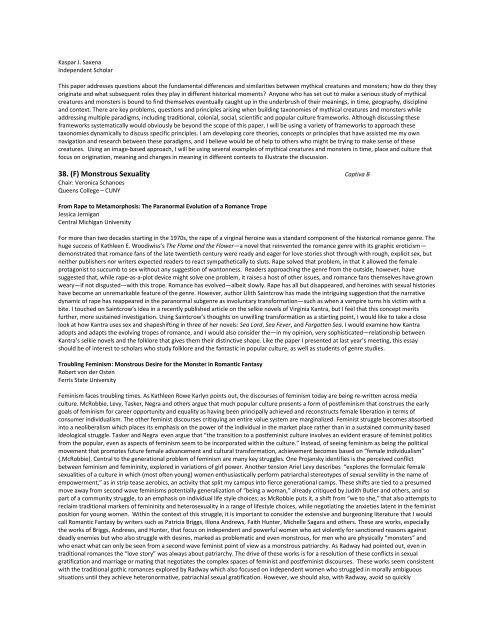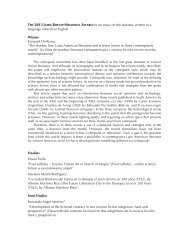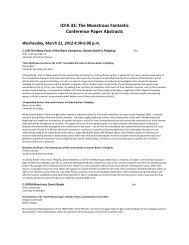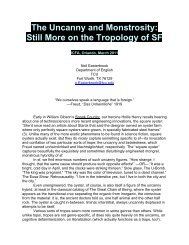32. (CYA) Neil Gaiman’s Books for Children MapleChair: Daryl RitchotUniversity of British Colombia OkanaganThresholds and Depths: <strong>The</strong> Submerged and the Guardians of the Thresholds in Neil Gaiman's Sandman and <strong>The</strong> Graveyard BookKacey DoranHollins UniversityThis paper explores how Neil Gaiman uses the old associations of the serpent in Western Art to raise questions about gender and identity in hisstories “Hob’s Leviathan”, a comic in the Sandman series, and <strong>The</strong> Graveyard Book. In “Hob’s Leviathan”, the sea serpent acts as the guardianand the symbol of the thresholds of reality/fantasy and man/woman. <strong>The</strong> main character Jim, who is later revealed to be Peggy, discovers thatthere are fantastic parts of the world like the sea serpent that are just as real as the ordinary, and the reader discovers that a more integral partof Peggy’s identity is being on the open ocean and not a gender association. This progressive move by Gaiman keeps with the socialdeconstruction work done by such scholars as Kate Bornstein. Gaiman also takes a twist on identity with a serpent-like creature in <strong>The</strong>Graveyard Book, where his protagonist Nobody Owens discovers who he is with the help of the ancient guardians of a tomb, the Sleer. Nobodyis a living boy who can communicate with ghosts and lives in a graveyard, and cannot figure out whether he belongs in the world of the living orthe dead. Nobody discovers his real name with the help of the Sleer, and therefore his place in life: Nobody. He does not need to exist in onerealm or the other, and is unique in that he understands both the worlds of the living and the dead. Unlike Lee Upton, who explores thenegative connotations of the monsters in the work of Rachel Ingall, Kacey Doran shows how Gaiman gives his monsters a positive spin; thus, thefantastic continue to thrive in modern fiction, and provide a healthy space for the questioning of socially constructed genders and identities bychildren and teenagers.Monster Parents, Normal Kids?: Neil Gaiman's Coraline, <strong>The</strong> Wolves in the Walls, <strong>The</strong> Day I Swapped My Dad for Two Goldfish, and <strong>The</strong>Graveyard BookMarek OziewiczUniversity of WrocławOne of the most popular fantasy writers today, Neil Gaiman has been notorious for representing parents as monsters—physical, psychologicaland/or emotional. His child characters are always puzzled about their parents’ or parent figures’ monstrosity, yet learn to accept it as part ofwhat their parents are. In Gaiman’s fiction, to be a normal kid one must have monster parents. This essay examines a selection of Gaiman’s YAfantasy—Coraline (2002), <strong>The</strong> Wolves in the Walls (2003), <strong>The</strong> Day I Swapped my Dad for Two Goldfish (2004) and <strong>The</strong> Graveyard Book (2009)—in which he uses the trope of parent monstrosity. My argument is that Gaiman projects the perception of parents as monsters—seen asirrelevant or even threatening to a child’s wellbeing—as a common phenomenon and an important developmental stage of childhood. Yet,unlike those children’s authors who, like Sendak, have either denied children’s perception of parents as monsters or, like Dahl, placated it byreplacing monstrous, insensitive parents with adult versions of children’s idealized playmates, Gaiman offers his readers a picture that is moreemotionally honest. He acknowledges parental monstrosity, but insists that it serves a vital purpose. If done away with, it would not provide achild with an opportunity to learn two lessons crucial for growing up. One, that the world will not change to suit one’s expectations; two—thateach one of us is a monster of sorts. In struggling to come to terms with their parents’ and their own monstrosity, Gaiman’s protagonists thuslearn that lasting human relationships are built not in the absence of but despite our own and other people’s shortcomings.36. (F/IF) Original Monsters in New Forms DogwoodChair: Elizabeth Whittingham<strong>The</strong> College at Brockport - SUNYChaos and Companionship: How Urban Fantasies Use Wolves and Ravens from Norse MythsEmil Hjörvar PetersenLund University<strong>The</strong> wondrous and monstrous fauna of mythologies is frequently brought into fantasy fiction. This paper focuses on how creatures from Norsemythology, namely wolves and ravens, are depicted in urban fantasies. Fantasy is a genre which depends on realism unlike the myths andfolktales that feed into it, or as Brian Attebery puts it: “[Fantasy] is a form that makes use of both the fantastic mode, to produce theimpossibilities, and the mimetic, to reproduce the familiar” (Strategies of Fantasy, p. 16–17). Rendering mythological aspects realistically makesthe myths more prominent and detailed, especially when they are set in what seems to the reader to be a familiar setting. Moreover, urbanfantasy as a mode – and as low fantasy – makes use of myths in conjunction with the type of fantastic that intrudes reality. I will concentrate onwolves and ravens, examining similarities and differences, in two urban fantasies: American Gods (2001) by Neil Gaiman and Norse Code (2009)by Greg van Eekhout, where, in both cases, the main intrusion is the Norse pantheon. <strong>The</strong> juxtaposition of Norse mythic brutality and modernlocations and sensibilities results in a specific representation of wolves and ravens. In Norse mythology, ravens are not seen as tricksters, but ascreatures of wisdom, guidance and companionship. In both stories in question, the ravens become guides in a disorienting urban setting,bringing a balance to a story which is otherwise filled with motifs of trickery and chaos. <strong>The</strong> other dominating animal of Norse mythology, thewolf, brings disruption into the urban setting. In Norse Code, wolves are symbols of ill omens and their intrusion on reality initiates anescalation of chaos. Being creatures of chaos, but also of terrible greed, wolves are used to underscore the apocalyptic theme. Meanwhile, theravens, as narrators and companions, counterbalance the narrative. Gaiman frequently uses animal imagery in American Gods, where it isrelated to the gods, such as Odin, but the relation is never coincidental.<strong>The</strong> Monster Gardens: How Do Mythical Creatures and Monsters Originate, And What Happens After That?
Kaspar J. SaxenaIndependent ScholarThis paper addresses questions about the fundamental differences and similarities between mythical creatures and monsters; how do they theyoriginate and what subsequent roles they play in different historical moments? Anyone who has set out to make a serious study of mythicalcreatures and monsters is bound to find themselves eventually caught up in the underbrush of their meanings, in time, geography, disciplineand context. <strong>The</strong>re are key problems, questions and principles arising when building taxonomies of mythical creatures and monsters whileaddressing multiple paradigms, including traditional, colonial, social, scientific and popular culture frameworks. Although discussing theseframeworks systematically would obviously be beyond the scope of this paper, I will be using a variety of frameworks to approach thesetaxonomies dynamically to discuss specific principles. I am developing core theories, concepts or principles that have assisted me my ownnavigation and research between these paradigms, and I believe would be of help to others who might be trying to make sense of thesecreatures. Using an image-based approach, I will be using several examples of mythical creatures and monsters in time, place and culture thatfocus on origination, meaning and changes in meaning in different contexts to illustrate the discussion.38. (F) <strong>Monstrous</strong> Sexuality Captiva BChair: Veronica SchanoesQueens College – CUNYFrom Rape to Metamorphosis: <strong>The</strong> Paranormal Evolution of a Romance TropeJessica JerniganCentral Michigan UniversityFor more than two decades starting in the 1970s, the rape of a virginal heroine was a standard component of the historical romance genre. <strong>The</strong>huge success of Kathleen E. Woodiwiss’s <strong>The</strong> Flame and the Flower—a novel that reinvented the romance genre with its graphic eroticism—demonstrated that romance fans of the late twentieth century were ready and eager for love stories shot through with rough, explicit sex, butneither publishers nor writers expected readers to react sympathetically to sluts. Rape solved that problem, in that it allowed the femaleprotagonist to succumb to sex without any suggestion of wantonness. Readers approaching the genre from the outside, however, havesuggested that, while rape-as-a-plot device might solve one problem, it raises a host of other issues, and romance fans themselves have grownweary—if not disgusted—with this trope. Romance has evolved—albeit slowly. Rape has all but disappeared, and heroines with sexual historieshave become an unremarkable feature of the genre. However, author Lilith Saintcrow has made the intriguing suggestion that the narrativedynamic of rape has reappeared in the paranormal subgenre as involuntary transformation—such as when a vampire turns his victim with abite. I touched on Saintcrow’s idea in a recently published article on the selkie novels of Virginia Kantra, but I feel that this concept meritsfurther, more sustained investigation. Using Saintcrow’s thoughts on unwilling transformation as a starting point, I would like to take a closelook at how Kantra uses sex and shapeshifting in three of her novels: Sea Lord, Sea Fever, and Forgotten Sea. I would examine how Kantraadopts and adapts the evolving tropes of romance, and I would also consider the—in my opinion, very sophisticated—relationship betweenKantra’s selkie novels and the folklore that gives them their distinctive shape. Like the paper I presented at last year’s meeting, this essayshould be of interest to scholars who study folklore and the fantastic in popular culture, as well as students of genre studies.Troubling Feminism: <strong>Monstrous</strong> Desire for the Monster in Romantic FantasyRobert von der OstenFerris State UniversityFeminism faces troubling times. As Kathleen Rowe Karlyn points out, the discourses of feminism today are being re-written across mediaculture. McRobbie, Levy, Tasker, Negra and others argue that much popular culture presents a form of postfeminism that construes the earlygoals of feminism for career opportunity and equality as having been principally achieved and reconstructs female liberation in terms ofconsumer individualism. <strong>The</strong> other feminist discourses critiquing an entire value system are marginalized. Feminist struggle becomes absorbedinto a neoliberalism which places its emphasis on the power of the individual in the market place rather than in a sustained community basedideological struggle. Tasker and Negra even argue that “the transition to a postfeminist culture involves an evident erasure of feminist politicsfrom the popular, even as aspects of feminism seem to be incorporated within the culture.” Instead, of seeing feminism as being the politicalmovement that promotes future female advancement and cultural transformation, achievement becomes based on “female individualism”(.McRobbie). Central to the generational problem of feminism are many key struggles. One Projansky identifies is the perceived conflictbetween feminism and femininity, explored in variations of girl power. Another tension Ariel Levy describes “explores the formulaic femalesexualities of a culture in which (most often young) women enthusiastically perform patriarchal stereotypes of sexual servility in the name ofempowerment,” as in strip tease aerobics, an activity that split my campus into fierce generational camps. <strong>The</strong>se shifts are tied to a presumedmove away from second wave feminisms potentially generalization of “being a woman,” already critiqued by Judith Butler and others, and sopart of a community struggle, to an emphasis on individual life style choices; as McRobbie puts it, a shift from “we to she,” that also attempts toreclaim traditional markers of femininity and heterosexuality in a range of lifestyle choices, while negotiating the anxieties latent in the feministposition for young women. Within the context of this struggle, it is important to consider the extensive and burgeoning literature that I wouldcall Romantic Fantasy by writers such as Patricia Briggs, Illona Andrews, Faith Hunter, Michelle Sagara and others. <strong>The</strong>se are works, especiallythe works of Briggs, Andrews, and Hunter, that focus on independent and powerful women who act violently for sanctioned reasons againstdeadly enemies but who also struggle with desires, marked as problematic and even monstrous, for men who are physically “monsters” andwho enact what can only be seen from a second wave feminist point of view as a monstrous patriarchy. As Radway had pointed out, even intraditional romances the “love story” was always about patriarchy. <strong>The</strong> drive of these works is for a resolution of these conflicts in sexualgratification and marriage or mating that negotiates the complex spaces of feminist and postfeminist discourses. <strong>The</strong>se works seem consistentwith the traditional gothic romances explored by Radway which also focused on independent women who struggled in morally ambiguoussituations until they achieve heteronormative, patriachial sexual gratification. However, we should also, with Radway, avoid so quickly
- Page 4 and 5: 5. (F) Wondrous Bodies of the Gende
- Page 6 and 7: Fantastic Suicide: Reading the Unca
- Page 8: Viral Posthumanism: Boundaries and
- Page 11 and 12: The Concept of Soul Divisibility in
- Page 13 and 14: Thursday, March 22, 2012 10:30 a.m.
- Page 15 and 16: 21. (CYA) Terrifying Futures: Post-
- Page 17 and 18: 23. (FTV/H) Now I’m Feelin’ Zom
- Page 19 and 20: Fight Club: Amalgam of the Horrific
- Page 21: Taking the Monsters out of the Clos
- Page 25 and 26: 44. (CYA) The Monstrosity of Teenag
- Page 27 and 28: 46. (FTV/SF) Monstrous Spin-offs: T
- Page 29 and 30: 49. (F) Aspects of Miéville Captiv
- Page 31 and 32: 53. (SF) War and Crisis in 1940s an
- Page 33 and 34: Abuse of Power: An Evolutionary Res
- Page 35 and 36: Disappearing Natives: The Colonized
- Page 37 and 38: 60. (H/IF) Ancient and Medieval Mon
- Page 39 and 40: 62. (F) The Works of Tolkien Captiv
- Page 41 and 42: 67. (SF) Imperial and Postcolonial
- Page 43 and 44: Beheading the Gorgon: Beautifying C
- Page 45 and 46: 71. (VPA) Monstrous Music MagnoliaC
- Page 47 and 48: 73. (F/IF) Portraying New Worlds Ca
- Page 49 and 50: Friday, March 23, 2012 2:45-3:45 pm
- Page 51 and 52: 81. (FTV) Those Damn Dirty Apes! Cy
- Page 53 and 54: Friday, March 23, 2012 4:00-5:30 pm
- Page 55 and 56: 92. (F) Leaving the Demonized Other
- Page 57 and 58: 94. (FTV/CYA) Monstrosity and Devia
- Page 59 and 60: of cannibalism, ghostly seduction i
- Page 61 and 62: Saturday March 24, 2012 8:30-10:00
- Page 63 and 64: 104. (CYA) Classic Monsters, Reinte
- Page 65 and 66: 107. (VPA) Monstrous Gaming Bodies
- Page 67 and 68: who challenge the order that the Br
- Page 69 and 70: Reading Between the Times: A Critic
- Page 71 and 72: 117. (FTV) Monsters and Superheroes
- Page 73 and 74:
119. (IF/H/PCS) International Mash-
- Page 75 and 76:
Focusing on Stoker's Dracula as one
- Page 77 and 78:
Florida Atlantic UniversitySheri S.
- Page 79 and 80:
Simmons CollegeIn the spate of rece
- Page 81 and 82:
Independent ScholarKing’s story
- Page 83 and 84:
modernity opens up for every indivi
- Page 85 and 86:
Saturday March 24, 2012 4:00-5:30 p
- Page 87 and 88:
141. (FTV) Monstrous Masculinity Cy
- Page 89 and 90:
ultimately make peace with her mons
- Page 91 and 92:
where the almost-human sentient zom





